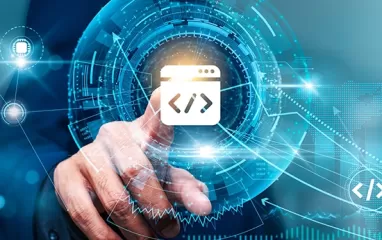Other recent blogs
Let's talk
Reach out, we'd love to hear from you!
IoT frameworks are designed to accelerate the development process of IoT applications and solutions. You can build secure and scalable solutions using either an open-source framework or a proprietary framework. However, choosing a framework that aligns with your needs is critical to the success of your project.
In this blog, we’ll briefly define an IoT framework and provide an overview of the most prominent open-source and proprietary ones.
What is an IoT framework?
An IoT framework provides a solid foundation for your application. Since you do not have to develop your product from scratch, you can build future-proof solutions quickly, improving your time to market and helping you create a competitive edge.
There are both open-source and proprietary IoT frameworks out there. However, open-source doesn’t necessarily mean you’ll get everything for free—that’s a misconception. Open-source usually indicates that the source code is available for everyone to use and improve. On the other hand, tech giants, such as Amazon Web Services, Google Cloud, and Cisco, offer proprietary, paid IoT Platforms.
Popular open-source IoT frameworks:
Open-source IoT frameworks or platforms provide developers with powerful features and capabilities to accelerate the development cycle while ensuring flexibility and scalability. DeviceHive, Mainflux, and Thinger.io are among the best IoT development and management platforms.
1. DeviceHive
DeviceHive is an open-source IoT data platform that helps you build innovative and scalable IoT/M2M solutions. The framework accelerates IoT development and creates secure, cost-effective solutions and applications for various industries.
DeviceHive is a microservice-based framework that supports Python, Node.js, and Java client libraries. IoT developers use DeviceHive for its range of deployment and operations options, which include Docker, Docker-compose, manual installation, and Kubernetes. Development teams can use its robust ecosystem of plugins for customization and extensibility.
2. Mainflux
Mainflux is a secure, scalable, and open-source framework for developing and managing Internet of Things solutions. Development teams can deploy Mainflux across on-premises, cloud, or hybrid environments depending on the project's needs. Leading IoT development companies use this framework to streamline all aspects of their development projects, including data, device, event management, core analytics, application enablement, and more.
Mainflux enables developers to integrate new functionalities and features into their projects using its easy-to-use APIs (Application Programming Interfaces), which enable seamless integration with ERPs, CRMs, databases, analytics programs, etc. In addition, organizations also benefit from Mainflux’s low OPEX (operating expense) due to its design and selection of core technologies.
3. Thinger.io
Thinger.io is a Cloud-based IoT Framework that lets IoT developers connect thousands of devices in minutes. With Thinger.io, you can get started with a lifetime freemium account and build and scale complex IT projects using its ever-evolving ecosystem of tools and an online community that helps you at every step of the development process.
According to the official website, the goal behind building and improving this platform is to democratize the use of IoT, making it accessible to the whole world and streamlining the development of large-scale IoT projects.
4. Kaa enterprise IoT platform
Based on a flexible microservices architecture, the Kaa enterprise IoT platform provides everything you need to develop an enterprise-grade IoT application—from device connection and management to data collection, IoT dashboards, and analytics. You get access to full-stack capabilities that streamline the whole IoT development process.
Depending on your project needs, you can deploy the Kaa framework on-prem, in the cloud, or across both in a hybrid model. To manage your devices via the cloud, you can use Kaa Cloud, which lets you connect devices and manage analytics remotely. In addition to all these advantages, Kaa also keeps your data secure by encrypting it both in transit and at rest.
5. ThingSpeak
Another key IoT framework or platform is ThingSpeak. What makes this platform stand out from its competitors is the ease of use you experience while connecting your devices and sensors to ThingSpeak and how it lets you analyze all the data in real-time. So, you can consider an open-source IoT platform like ThingSpeak to aggregate, visualize, and analyze live data streams in the cloud.
ThingSpeak also allows users to write and execute MATLAB code to perform preprocessing, visualizations, and analyses. IoT development companies often leverage ThingSpeak to build IoT applications or prototyping and proof of concept (POC) IoT systems.
Proprietary IoT frameworks:
Proprietary IoT frameworks and platforms are robust solutions for building and developing secure and scalable IoT ecosystems. These platforms bring a new generation of tools and technologies your IoT teams can leverage to simplify and accelerate device connectivity, data management, and security.
1. Amazon Web Services IoT
AWS Internet of Things falls under the category of proprietary frameworks. It provides a broad and deep range of services and solutions to help IoT teams build intelligent IoT solutions with Artificial Intelligence (AI) and Machine Learning (ML) capabilities. With AWS IoT, an IoT team can easily connect and manage billions of devices and safeguard their device data with preventative mechanisms like encryption and access control.
IoT application development companies use AWS IoT offerings to complete complex IoT projects and streamline data analysis for industrial, commercial, customer, and automotive workloads. Additionally, the platform provides a highly secure and elastic infrastructure for IoT teams to scale easily and reliably.
2. Azure IoT
Azure IoT helps businesses build, deploy, and manage IoT applications at scale. IoT development agencies across the world tap into Azure’s IoT capabilities to develop IoT applications and solutions for manufacturing, retail, energy, healthcare, and logistics. The cloud services platform provides development teams with intelligent edge-to-cloud technologies and an ecosystem of thousands of partners to enable businesses to solve industry-specific business challenges.
3. IBM Watson IoT Platform
IBM Watson IoT Platform is a fully managed, cloud-based IoT platform that enables businesses to collect data from various objects—such as cars, buildings, equipment, and assets—and derive valuable insights.
The platform offers users a powerful web dashboard to streamline their IoT operations, including device management, secure communication, and complete data lifecycle management. Therefore, regardless of the market you operate in, you can always tap into IBM's massive ecosystem to make your surroundings smart, connect and configure devices, send data to the cloud, and control access to your IoT service.
4. Cisco IoT Solutions
Cisco powers digital transformation and process modernization programs across industries. Its industrial IoT solutions are designed to enable businesses in various sectors, including manufacturing, utilities, and roadways, to tap into the Internet of Things' transformative potential.
You can consider Cisco’s IoT platform and solutions to access its AI-ready networking solutions to drive connectivity and security while automating your industrial operations. Its multi-layered security protocols, such as encryption and network segmentation, protect your IoT networks from today’s highly sophisticated cybercrimes, which are rising at an alarming rate. Another critical component of Cisco’s IoT ecosystem is the Cisco IoT Control Center, a cloud-based platform that simplifies the deployment and management of large-scale IoT networks.
How to choose an IoT framework?
When choosing an IoT framework, you can consider the following things:
- A future-proof IoT platform: Invest in a secure, scalable framework that can evolve with the market. IoT is still in an early phase, and many new technologies will likely impact its ecosystem. That’s why you should consider a platform that continuously updates itself in line with the latest standards and protocols that emerge in the IoT landscape, whether they impact the system or cloud environment, security stack, or end-point applications.
- Security: This aspect of IoT development is crucial for the success of your project. Thoroughly analyze the security aspects of any IoT platform. Choosing a secure framework will ensure that your confidential or third-party data and information is safe and secure and that breaches and other cyber attacks do not ruin your business reputation.
- Time-to-value: The ideal framework should simplify and accelerate your development and deployment process. Look for platforms that provide end-to-end solutions so you do not have to build your PoC using one framework and develop and deploy on another. Using a platform that provides full-suite IoT capabilities often leads to faster time to market and more secure and reliable products.
- Pricing: It’s one of the critical considerations in the selection of an IoT framework. Understand the pricing models of all potential IoT platforms. Speak with their teams. Look for hidden costs (if there are any) so no surprises await you when you are about to close a deal or start building a project.
- Don’t overcommit to one scenario: The success of an IoT project depends on the tech stack and resources you use to connect, control, and secure your devices and applications. Cloud computing is a powerful technology, but you may also need to run some workloads across edge and on-premises. So, it is essential not to overcommit to one scenario and to have the bandwidth to use modern architecture to reach a broader customer base while not compromising data security and compliance.
Accelerate IoT development with Kellton
We are a global IoT solutions provider with many talented consultants, designers, and developers. Backed by deep domain and cross-industry experience, we can help you choose an IoT platform that best meets your project needs. Clients worldwide tap into our global network of talent to build secure solutions that help you drive real business growth.
With Kellton as your IoT development partner, you can focus on your core business while having a team that works with your best interests in mind. We’d love to talk about your next IoT project.
Originally published on Sep 2022






